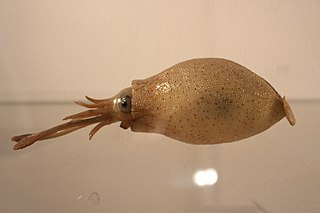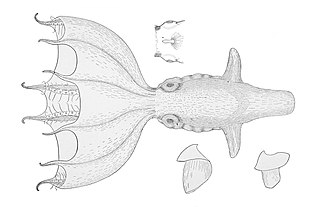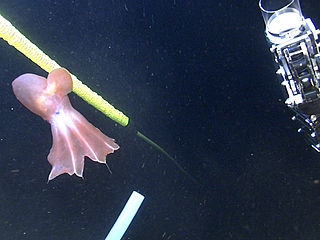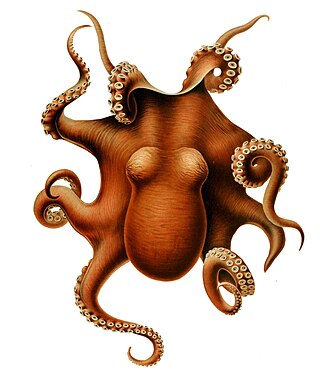
A squid is a mollusc with an elongated soft body, large eyes, eight arms, and two tentacles in the orders Myopsida, Oegopsida, and Bathyteuthida. Like all other cephalopods, squid have a distinct head, bilateral symmetry, and a mantle. They are mainly soft-bodied, like octopuses, but have a small internal skeleton in the form of a rod-like gladius or pen, made of chitin.

Spirula spirula is a species of deep-water squid-like cephalopod mollusk. It is the only extant member of the genus Spirula, the family Spirulidae, and the order Spirulida. Because of the shape of its internal shell, it is commonly known as the ram's horn squid or the little post horn squid. Because the live animal has a light-emitting organ, it is also sometimes known as the tail-light squid.

Ancistrocheirus lesueurii, the sharpear enope squid, is the only species in the genus Ancistrocheirus and family Ancistrocheiridae. With a mantle length of 25 cm (9.8 in), this moderately sized squid may be found throughout the tropical and subtropical oceans. They tend to be found at mesopelagic depths.
Liguriella is a genus of glass squids, the genus is probably monotypic, the only species being Liguriella podophthalma. The other named species Liguriella pardus, which was described by S. Stillman Berry in 1916, is cited as a taxon inquirendum but it is suggested that there may be in fact more than one species and there are species yet to be described.
Egea inermis is a species of glass squid in the monotypic genus Egea.

Bathothauma lyromma, the lyre cranch squid, is a highly modified species of glass squid from the family Cranchiidae with a distribution which encompasses most of the world's oceans from the tropics to high latitudes.

Cranchia scabra is a species of glass squid. It is the only species in the genus, and is fairly small. They reside in the epipelagic zones of the tropical Atlantic. The genus also contains bioluminescent species. Cranchia scabra are named after John Cranch who first described this species.

Idioteuthis cordiformis is a species of whip-lash squid found in tropical regions of the west Pacific Ocean. The species is commonly known as the 'love-heart squid' because the species name cordiformis is Latin for 'heart shaped'. Recently, this species has been found to consume small birdbeak dogfish.

Rossia palpebrosa, also known as the warty bobtail squid, is a species of bobtail squid native to the northern Atlantic Ocean.

Velodona togata is a species of octopus in the monotypic genus Velodona. First described by Carl Chun in 1915, with a second subspecies discovered by Guy Coburn Robson in 1924, it was named for the distinctive membranes on its arms.
Thaumeledone is a genus of octopuses in the family Octopodidae found in deep waters in the Southern Hemisphere.
Stigmatoteuthis arcturi, commonly known as the jewelled squid, is a species of cock-eyed squid from the family Histioteuthidae. It occurs throughout the subtropical and tropical Atlantic Ocean in the mesopelagic zone.

Stauroteuthis syrtensis, also known as the glowing sucker octopus or bioluminescent octopus, is a species of small pelagic octopus found at great depths in the north Atlantic Ocean. It is one of a very small number of octopuses to exhibit bioluminescence.

Bathyteuthis abyssicola, also known as the deepsea squid, is a species of squid in the family Bathyteuthidae.

Cirroteuthis muelleri, also known as the big-finned jellyhead, was the first cirrate octopus species to be scientifically described. It is closely related to the genus Cirrothauma within the family Cirroteuthidae. At present the genus contains a single recognized species restricted to the Arctic Ocean and northern basins of the Atlantic and Pacific, but other species may be present in the southern hemisphere.

Muusoctopus levis is a species of octopus in the family Enteroctopodidae. It was first described by William Evans Hoyle in 1885 in an article in the Annals and Magazine of Natural History detailing the new species of octopus found on HMS Challenger as part of the Challenger expedition; the type specimen was retrieved from the Southern Ocean. The species is found in subantarctic waters in the Southern Ocean, particularly surrounding Heard Island and Kerguelen Island, but specimens comparable to M. levis have also been found at the Antarctic Peninsula.

Heteroteuthis dispar, also known as the odd bobtail, is a small deep water squid found in the North Atlantic Ocean and the Mediterranean Sea.

Illex coindetii, commonly known as the southern shortfin squid or broadtail shortfin squid, is a species of neritic squids in the family Ommastrephidae. They are found in the Mediterranean Sea and on both sides of the north Atlantic Ocean.

Teuthowenia megalops, sometimes known as the Atlantic cranch squid, is a species of glass squid from the subarctic and temperate waters of the northern Atlantic Ocean. They are moderately sized squid with a maximum mantle length of 40 cm (16 in). Their very large eyes are the source for the specific name megalops. Like other members of the genus Teuthowenia, they are easily recognizable by the presence of three bioluminescent organs (photophores) on their eyeballs.
Eucleoteuthis is a monotypic genus of squid from the family Ommastrephidae; the only species is Eucleoteuthis luminosa, the striped flying squid or luminous flying squid.














